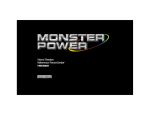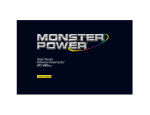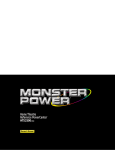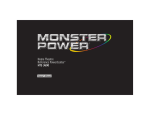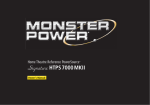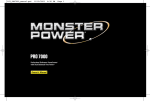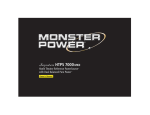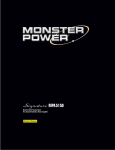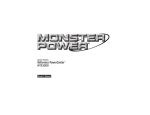Download Monster Cable Signature HTPS 7000 MKII Owner`s manual
Transcript
® Home Theatre Reference PowerSource ™ HTPS 7000 Owner’s Manual TABLE OF CONTENTS Important Safety Precautions ... ii Proper Grounding and Installation Tips .................................................................................................................... v A Note from The Head Monster ..............................................................................................................................1 The Minds Behind the Monster® PowerSource™ ......................................................................................................3 Hookup Guide ........................ 4 Grounding Your Cable TV, Satellite Dish, and Antenna Connections .......................................................................16 HTPS 7000 Features ............. 17 Troubleshooting .................... 22 Frequently Asked Questions .. 26 Appendix Glossary of Terms ................. 28 i IMPORTANT SAFETY PRECAUTIONS Please read and observe the following safety points at all times. WARNING - PowerSources™ Do not plug your Monster® PowerSource into a power outlet that differs from the source indicated for safe use of the Monster PowerSource. If you don’t know the type of electrical power that is supplied to your home, please consult your local power company. WARNING - Grounding and Polarization A. Your Monster PowerSource has a three-wire grounding-type AC plug (a three-prong plug). This plug is designed to be inserted into a grounding-type outlet only. If this plug doesn’t fit directly into your outlet, do not attempt to force it. [Never attempt to dismantle the plug in any way (or to alter an extension cord) to make it fit into a two-prong outlet. Do not attempt to defeat the grounding feature by using a 3-to-2 prong adapter. Instead, call a local electrician to install a properly grounded outlet.] B. If you use rooftop devices such as Satellite dishes, antennas, or any other component with wire that connects to your PowerSource, be sure the wire(s) is properly grounded. Use grounding techniques specified in Section 810 of the National Electrical Code (NEC), ANSI/NFPA 70 (in Canada, Part 1 of the Canadian Electrical Code). This protects against harmful voltage surges and static discharges, Do not place any part of an antenna near overhead power lines, or any other power circuit. Do not touch any power line or power circuit. Doing so may cause severe physical injury and may result in death. ii WARNING - Liquid: Avoiding Electrical Shocks Do not operate your Monster® PowerSource™ if liquid of any kind is spilled onto or inside the unit. Do not operate your Monster PowerSource near rain or water that’s spilled or openly exposed (e.g., bathtub, kitchen or bathroom sink). WARNING - Power Cord Safety A. When routing your Monster PowerSource AC power cord, do not place it near heavy foot traffic areas (e.g., hallways, doorways, and kitchen floors). Do not create a trip hazard with the power cord. B. If your power cord’s protective jacket begins to rip or fray, exposing the internal wiring, shielding, etc., disconnect it from the PowerSource and discontinue use of the Monster PowerSource immediately. WARNING - Proper Cleaning In general, the only cleaning necessary for your Monster PowerSource is a light dusting. Unplug your component from the wall outlet before cleaning it. Do not use any type of liquid or aerosol cleaners. iii WARNING - Storm Precautions In the event of a lightning storm, immediately disconnect your Monster® PowerSource™ from its power source. It’s not necessary to disconnect any components from your Monster PowerSource. WARNING - No User Serviceable Parts Inside If, for any reason, your Monster PowerSource is not operating properly, do not remove any part of the unit (cover, etc.) For repair. Unplug the unit and consult this owner’s manual for service information. CAUTION - Exposure To Heat Do not expose your Monster PowerSource to direct sunlight or place it near wall heaters, space heaters, or any enclosed space prone to temperature increase (e.g., car trunk). iv PROPER GROUNDING AND INSTALLATION TIPS CAUTION - Proper Grounding Monster® PowerSource™ requires a properly grounded 3-wire outlet to protect connected equipment. If your AC outlet is improperly wired (no ground or reverse polarity), the green ”SYSTEM GROUNDED” LED on the front panel of the Home Theatre Reference PowerSource HTPS 7000 will not light up. In this event, call a qualified electrician to fix the problem in your home’s wiring. Many older buildings are inadequately wired. It’s very common for a building to be improperly grounded. Building wiring and grounding must conform to applicable NEC (USA) or CEC (Canada) codes for the $750,000 Limited Connected Equipment Warranty to be valid. If you’re not sure about your home’s wiring, have it checked by a qualified electrician. Note to CATV Installer This reminder is provided to call the CATV System Installer’s attention to Article 820-40 of the NEC that provides specific guidelines for proper grounding and in particular, specifies that the cable ground shall be connected to the point of cable entry as practical. IMPORTANT NOTE- Proper Power and Protection To completely deliver Monster Clean Power™ and protect your equipment from electrical surges, every phone, coaxial cable, and AC power cord in your system must be connected to an appropriate Monster PowerSource outlet. v A LETTER FROM THE HEAD MONSTER Dear Enthusiast, Thank you for purchasing the Monster Power® Home Theatre Reference PowerSource™ HTPS 7000. The PowerSource reflects Monster’s commitment to creating performance-enhancing solutions for audio and home theater systems, so you will enjoy superior picture and sound quality. Ordinary AC power accessories may seriously compromise the equipment they power. The PowerSource's advanced technologies and innovative design solve this problem and offer unique convenience and performance features. Noel Lee While your PowerSource does an excellent job of protecting your components from harmful power surges, its main benefit is much more than just surge protection. Exclusive Monster Clean Power™ filter circuitry virtually stops the noise that goes right through typical surge protectors. It isn’t enough to only have filtering from a noisy incoming power line. That’s why your PowerSource also features revolutionary separate isolation for digital, audio, and video outlets. If any noise from an electronic product plugged into an outlet gets through our Monster Clean Power™ noise filters and to the power line, it will have to go through another filter to get to an adjacent set of outlets. The result is high quality picture and sound that’s free from performance-damaging interference. Another Monster Power breakthrough is the ultra-low loss RF circuitry. While other line conditioners feature coaxial outlets for convenience, their insertion loss of these outlets can be up to 30dB. The PowerSource's incredibly small insertion loss makes it ideal for all digital coaxial connections, such as Satellite or DBS. Your PowerSource also features an exclusive color-coding system which identifies which component should be plugged in where and by outlet filter type (digital, high-current audio, analog audio, and video). This way, you won’t jeopardize performance by plugging a high-current audio component into an analog audio outlet. As fellow audiophiles and videophiles, we designed your PowerSource for the best sound and picture. Enjoy! 1 Noel Lee, The Head Monster MONSTER® PATENTED CLEAN POWER™ STAGES Monster Clean Power performs two tasks vital to high-performance audio, video and digital reproduction: filtration and isolation. The higher the Monster Clean Power stage number, the more sophisticated and advanced the filters are, to reject noise generated on the AC powerline. Also, the higher the Monster Clean Power stage, the more isolation between connected equipment for maximum component-generated noise rejection. HTPS 7000 features Monster Clean Power Stage 5 with balanced transformers for the best possible performance. Monster Clean Power Stage 5: Five ultra-advanced isolation filters including two separate digital filters for separate digital sources, analog audio, video, and ultra-high-current audio filters provide the best AC powerline noise rejection and isolation of audio equipment from video equipment for improved component-generated noise rejection. Ideal for audiophile and videophile A/V systems and reference home theater systems. Actual spectrum analyzer photo of AC power pollution 2 AC power line filtered by Monster Clean Power™ THE MINDS BEHIND THE MONSTER® POWERSOURCE™ Richard Marsh – There are few experts able to solve the complex problems of AC power, and Richard Marsh is one of the illustrious few. He has designed best selling power conditioning components costing more than $3,000 and now brings his expertise to Monster Power®. Richard developed Monster exclusive Clean Power™ circuitry. He is also responsible for several other groundbreaking designs. Richard’s background and research into amplifier and capacitor design led to his development of the Servo-DC feedback circuit for power amplifiers—a concept that is used by virtually every amplifier manufacturer today. His status as both the inventor of the MultiCap internal bypass capacitor and as the driving force behind the highend audio balanced circuit design concept has influenced the audiophile community for years. Richard is responsible for some of the high-end audio world’s most respected product designs, essays and articles, and has contributed to Fi, The Absolute Sound and Audio magazine. He is included in Who’s Who in the West. Demian Martin – Demian Martin has been solving complex AC power problems for several years. As a technical consultant for successful paper and steel mills, Demian helped create several innovative AC power solutions. He developed techniques to dramatically improve the efficiency of these factories’ high power motor control systems – up to 50,000 watts — helping them avoid the costly premiums many factories must pay for AC power inefficiency. Demian was also the co-founder of Spectral Audio and was the chief designer of their many pioneering designs for amplifiers, D/A converters, and other high-end audio designs. He now brings his expertise to Monster Power’s elite research and development team. Noel Lee – Noel Lee is best known for popularizing the concept of high performance audio cable over 20 years ago with his creation of Monster Cable. Originally a laser-fusion design engineer at Lawrence Livermore National Laboratory and later a touring musician, Noel has invented or co-invented over 125 U.S. and international patents and drives the explosive growth of Monster into more than 80 countries worldwide. Monster Power is his realization of a long-nurtured vision of making affordable power solutions that deliver the best possible sound and picture. 3 HOOKUP GUIDE STEP 1 DSS/DVD/Phone line Hookup The PowerSource™ has facilities to protect a single phone line. FOR PAY-PER-VIEW DEVICES (SUCH AS DBS) A) Connect one end of a phone cable into a telephone wall jack. Plug the other end into the HTPS 7000 “IN” jack (Figure 1a). B) Connect a second phone cable from the HTPS 7000 “OUT” jack to the Pay-Per-View input on your DSS Receiver or DVD player (Figure 1b). FOR STANDARD TELEPHONE LINE PROTECTION (NOT A PAY-PER-VIEW DEVICE) A) Connect a phone cable from a telephone wall jack to the HTPS 7000 “IN” jack (Figure 1a). B) Connect a second phone cable from the HTPS 7000 “OUT” jack to the telephone (Figure 1b). 4 STEP 2 Outlet Programming All of the PowerSource's outlets located on the rear panel are "programmable". This means in order to program each outlet pair, you must use the front panel buttons “MENU” and “SET” (Figure 2). These buttons enable you to program between “switched on”, “switched on after delay” and “unswitched" (always on) settings independently on each outlet pair. You can change the settings, when necessary. Using the outlet pair labeled as “AUDIO FILTER” as an example, the following diagrams illustrate how to program the outlets: A) Power up the PowerSource: Press the “ON/OFF” switch once to power on the unit. The unit will start the power on process. Once the process is finished, the display will show the main line voltage similar to Figure 2. Note: The power-on process may take up to 60 seconds since any outlet pair can be configured as “Switched on after Delay”. You can see any outlet pair’s power status LED on the front panel (refer to page 17) B) Set Outlet Pair to “Switched On”: Press “MENU” until the display shows the status of the AUDIO outlet pair. Press “SET” button until the DELAY TIME changes to “0” (zero), the display will resemble Figure 3. The “0” (zero) delay time setting indicates “Switched On” mode for the AUDIO outlet pair. This outlet pair will be live once the PowerSource is switched on by pressing the front panel “ON/OFF” button, or by an external signal. 5 C) Set the Outlet Pair to “Switched On After Delay”: Press “MENU” until the display shows the status of the AUDIO outlet pair. Press the “SET” button until the DELAY TIME changes to the desired DELAY TIME in second(s) before this outlet pair will turn on. After the “ON/OFF” button is pressed, the display will resemble Figure 4. When the PowerSource is switched on by pressing the front panel ON button, or by external trigger signal, the outlet pair will be “live” after a delay set by the DELAY TIME—20 seconds in this case. The outlet pair which has a maximum time DELAY TIME setting will be turned off immediately once the PowerSource is switched off by pressing the front panel ON/OFF button or by external signal. D) Set the Outlet Pair to “Unswitched" (Always On): Press the “MENU” button until the display shows the status of the AUDIO outlet pair. Press the “SET” button until the display resembles Figure 5. Once the “Unswitched” is set (whether you turn your PowerSource on or off) any component plugged into those outlets can receive power continuously, as long as your PowerSource is plugged into a 120 volt wall socket. Note: The unit is shipped with all outlet pairs set to “Switched On”. 6 STEP 3 Over- and Under-Voltage Audible Alarm Setting This feature allows you the enable or disable the audible alarm for abnormal line voltage. When setting at “enable”, the unit will sound the alarm when the line voltage is higher than 130V or lower than 100V. A) Press “MENU” until the displays show: B) Press ”SET” to toggle between “enable” and “disable”. 7 STEP 4 Over- and under-voltage automatic shutdown setting This feature allows you to enable or disable the automatic shutdown feature for abnormal line voltage. When setting at “enable”, the unit will shutdown itself when the line voltage is higher than 134V or lower than 96V. A) Press “MENU” until the displays show: B) Press “SET” to toggle between “enable” and “disable”. 8 STEP 5 Remote AC Control Hookups This feature allows you to turn your PowerSource™ on/off via your A/V receiver or preamplifier. A) Plug the Remote AC Control Cord’s (included) female plug into your PowerSource REMOTE IN AC 120V jack (see diagram below). B) Plug the Remote AC Control Cord’s 2-prong male plug into a switched AC power outlet on a receiver or preamplifier. When you turn on your receiver or preamplifier, the PowerSource's outlets programmed as “switched on” will be turned on immediately. However, the PowerSource's outlets programmed as “switched on after delay” will be turned on after a delay set by the DELAY TIME setting. Illustration of rear panel showing remote in AC 120V 9 STEP 6 Remote DC Control Hookups This feature allows you to turn your PowerSource on/off via your Home Automated Control System. A component you don't want powered constantly (such as a projector or surround amplifier) can be plugged into one of the PowerSource's outlets as “switched on” or “switched on after delay” and can be remotely activated when needed. This feature also allows you to use a low voltage cable (not supplied) to remotely control multiple PowerSources. A) Plug a 1/8“ mini-plug cable (not supplied) into the REMOTE IN DC 3 - 30V outlet on the PowerSource (see diagram below). B) Plug the other end of the cable into the corresponding outlet on your component that has a 12 volt output. When you turn on the component that has a 12 volt output, the PowerSource’s outlets programmed as ”switched on” will be turned on immediately. However, the PowerSource's outlets programmed as “switched on after delay” will be turned on after a delay set by the DELAY TIME setting. A B 10 Illustration of rear panel showing remote in DC 3-30V STEP 7 Coaxial Outlet Hookup NOTE: You will need additional coaxial cables to connect the PowerSource™ to these components. Protect cable TV, satellite, and antenna connections as follows: See page 16 regarding proper grounding 11 STEP 8 High Power Audio AC Outlet Hookup Isolated Monster Clean Power™ Stage 5 Ultra-High Current Audio Filter: Optimized for maximum noise rejection, while providing maximum current to high-current audio components. NOTE: These outlets are designed to deliver maximum current to power hungry components such as amplifiers and receivers. You may want to program these outlets to be “switched on after delay” (see page 6, Figure 4) to enable sequential power activation. This way, power amplifiers are turned on last and turned off first to prevent speaker “thump”. See “STEP 2: Outlet Programming” (page 6) for details. A) Attach a Monster Power® ID label to each component’s power cord before you plug it into the appropriate color-coded PowerSource outlet. B) SUBWOOFER AMP & MAIN AMP: Plug the power cord of any separate subwoofer amp or main amp (not preamplifiers) into the PowerSource's corresponding SUBWOOFER AMP and MAIN AMP outlet. C) SURROUND AMP & A/V RECEIVER: Plug your dedicated surround amplifier's or receiver’s power cord into the corresponding SURROUND AMP and AV/RECEIVER outlet. 12 Illustration of rear panel showing High Power 1 and 2 STEP 9 Video AC Outlet Hookup Isolated Monster Clean Power™ Stage 5 Video Filter: Optimized to reduce noise generated by video equipment. Isolates video components from connected digital, analog audio and video components for maximum rejection of interference. NOTE: You may want to program these outlets to be “unswitched” (see page 7, fig.5) as some components perform best when powered continuously. A VCR, for example, should be plugged into one of these to avoid the hassle of resetting its clock if power is interrupted. Whether the PowerSource™ is on or off, any component plugged into these outlets can receive power continuously as long as your PowerSource is plugged into a properly grounded 120 volt wall socket, and the pair is programmed as “unswitched”. You can plug any type of analog video component (e.g., VCR, camcorder, TV, receiver) into these two Video AC outlets. A) Attach a Monster® Power ID label to each component’s power cord before you plug it into the color-coded PowerSource™ outlet. B) TV/PROJECTOR: Plug your TV or projector's power cord into the corresponding TV/PROJECTOR outlet. C) VCR: Plug your VCR power cord into the corresponding VCR outlet. Illustration of rear panel showing Video Filter 13 STEP 10 Digital 1 & 2 AC Outlet Hookup Isolated Monster Clean Power™ Stage 5 Digital Filter: Optimized to reduce noise generated by digital components. Isolates digital components from connected digital, analog audio and video components for maximum rejection of interference. The HTPS 7000 features two isolated filters to accommodate different digital sources. NOTE: You can plug any type of digital component (e.g., CD player, DVD player, cable TV box, digital camcorder) into the corresponding CD, DVD, CABLE/SAT, SPARE outlet. A) Attach a Monster® Power ID label to each component’s power cord before you plug it into the appropriate colorcoded PowerSource™ outlet. B) DVD: If you have a DVD player, plug its power cord into the corresponding DVD outlet. If you are using a LaserDisc player, you can also plug it into this outlet. If you have a LaserDisc player and a DVD player, you can plug either component into any of these four AC outlets designed for digital component. C) CABLE/SAT: If you have a cable TV box, plug its power cord into the PowerSource's corresponding CABLE/SAT outlet. If you are using a satellite receiver, plug its power cord into the same outlet. D) CD: Plug your CD player's power cord into the corresponding CD outlet. E) SPARE: Plug the power cord of your additional digital component (e.g. digital camcorder) into the corresponding SPARE outlet. 14 Illustration of rear panel showing Digital Filter 1 and 2 STEP 11 Analog Audio AC Outlet Hookup Isolated Monster Clean Power™ Stage 5 Analog Audio Filter: Optimized to provide maximum noise rejection for sensitive analog audio components. NOTE: Because certain components shouldn’t be turned on continuously, program these outlets to “Switched On” (see page 5, Figure 3). These components will receive power when your PowerSource™ is turned on, and lose it when the PowerSource is turned off. Plug any type of low-current analog audio component (preamplifier, tape deck) into the corresponding outlet. A) Attach a Monster® Power ID label to each component’s power cord before plugging it into the color-coded PowerSource outlet. B) PREAMP: Plug your preamplifier’s power cord into the corresponding outlet. C) SPARE: Plug the power cord of an additional analog component into the corresponding outlet. Illustration of rear panel showing Analog Filter 15 GROUNDING YOUR CABLE TV, SATELLITE DISH, AND ANTENNA CONNECTIONS IMPORTANT NOTE: Proper grounding can be accomplished by using a special grounding block attached to a cold water pipe or copper grounding rod driven into the earth. Consult with a qualified electrician to verify that your outdoor connections are properly grounded. 16 HTPS 7000 FEATURES PLEASE TURN TO PAGE 18-21 FOR DESCRIPTION OF PRODUCT FEATURES 17 HTPS 7000 FEATURES NUMBERS REFER TO DRAWINGS ON PAGE 17 18 1. On/Off Button: Press to provide AC power to outlets programmed as “switched on” or “switched on after delay”. Press again to shut down outlets programmed as “switched on” or “switched on after delay”. 2. Menu Button: Press to begin programming mode. 3. Set Button: Sets the parameters or options selected by the “Menu” button. 4. Dimmer Button: Sets the amount of light to the alphanumeric display. 5. Grounded OK LED: Indicates the PowerSource™ is plugged into a properly grounded 120V AC outlet. 6. Protection ON LED: Indicates Monster Power® Surge Protection Circuitry is functioning properly. 7. Monster Clean Power™ LED: Indicates the unit is powered on. 8. Abnormal Voltage LED: Indicates abnormal line voltage. You should turn the unit off to protect the PowerSource and the components plugged into it from abnormal line voltage. If the “Auto Shut Off” setting is enabled, the unit will automatically shut it receives abnormal voltage. 9. Wiring Reversed LED: Indicates that the line and neutral wires from the wall outlet to the PowerSource are reversed. Please consult your electrician to correct this immediately. 10. Audio Filter LED: Indicates the “Audio Filter” outlet pair has power. 11. Digital Filter 1 LED: Indicates the “Digital Filter 1” outlet pair has power. NUMBERS REFER TO DRAWINGS ON PAGE 17 12. Digital Filter 2 LED: Indicates the “Digital Filter 2” outlet pair has power. 13. Video Filter LED: Indicates the “Video Filter” outlet pair has power. 14. High Power 1: Indicates the “High Power 1” outlet pair has power. 15. High Power 2: Indicates the “High Power 2” outlet pair has power. 16. Alphanumeric Display: In normal operation, this eight-character LED alphanumeric display will display the line voltage. In programming mode, it will display options and settings. 17. Audio Filter: For low current analog audio components such as preamplifiers and tape decks, a special filter circuit reduces noise from the AC power line that would degrade audio performance. NOTE: It does not harm video components or digital components to be connected to the analog audio outlet section. However, for best possible performance, we recommend only plugging in low-current analog audio components here. 18. Audio Fuse: 2A slow-blow fuse protects the "Audio Filter" from power overload. Replace only with same type/rating fuse. 19. Digital Filter 1: For digital components such as CD players, DVD players, and satellite receivers, this special filter circuit is designed to reduce interference from your components such as digital noise from getting in the rest of your system. 20. Digital Filter 1: For digital components such as CD players, DVD players, and satellite receivers, this special filter circuit is designed to reduce interference from your components such as digital noise from getting in the rest of your system. 19 NUMBERS REFER TO DRAWINGS ON PAGE 17 21. Digital Fuse: 2A slow-blow fuse protects "Digital Filter 1" and "Digital Filter 2" from power overload. Replace only with the same type/rating fuse. 22. Video Filter Outlets: Special filter circuit designed to reduce interference (such as wide band noise that would disturb video performance) to your video components. NOTE: It does not harm audio components or digital components to be connected to the video outlet section. However, for best possible performance, we recommend only plugging in video components here. 23. Video Fuse: 10A slow-blow fuse protects the "Video Filter" from power overload. Replace only with the same type/rating fuse. 24. High Power Filter 1: For high current audio components such as a subwoofer amplifier and a main amplifier, a special filter circuit reduces noise from the AC power line that would degrade the audio performance and to optimize high current demand. NOTE: It does not harm low current audio components, video components or digital components to be connected to the high power outlet section. However, for best possible performance, we recommend only plugging in video components here. 25. High Power Filter 2: For high current audio components such as a subwoofer amplifier and a main amplifier, a special filter circuit reduces noise from the AC power line that would degrade the audio performance and to optimize high current demand. NOTE: It does not harm low current audio components, video components or digital components to be connected to the high power outlet section. However, for best possible performance, we recommend only plugging in video components here. 20 NUMBERS REFER TO DRAWINGS ON PAGE 17 26. 1/8th inch Mini-Plug Input for Remote DC Hookup: Enables remote control of the PowerSource's outlets. Accepts DC 3 to 30 volts. 27. Remote AC Hookup: Connects to a switched outlet on an external device. It enables remote control of the PowerSource's outlets. 28. 1/8th inch Mini-Plug Output for Remote DC Hookup: Enables remote control of an external device. 29. Cable TV Coaxial Input/Output: The input connects the coaxial cable from a wall cable outlet. The output connects the coaxial cable to the input of your TV, VCR or cable box. 30. Satellite Coaxial Input/Output: The input connects the coaxial cable from your satellite dish. The output connects the coaxial cable to the input of a satellite receiver. 31. Antenna Coaxial Input/Output: The input connects the coaxial cable from your TV antenna. The output connects the coaxial cable to the input of your TV, VCR or splitter. 32. Phone Line: Allows you to hook up one telephone. 33. Ground Post: Provides a ground reference point for ungrounded components. 34. Thermal Circuit Breaker: Protects the PowerSource™ from power overload. 35. Extra-long 8 ft. Ultra-High Current Powerline- Power Cord: For maximum power delivery and easy reach to outlets. 37. Monster Power® Color-Coded Audio/Video ID labels: For easy identification of your components and where they’re connected. 21 TROUBLESHOOTING PROBLEM – The PowerSource is not receiving power. Possible Cause #1: The PowerSource is not turned on. Possible Solutions: • Press the “ON/OFF” button on the PowerSource. • Make sure the PowerSource's AC power cord is plugged into a properly grounded 120V wall outlet. • In some households, a wall switch may need to be thrown to make the wall outlet come alive. Try turning on the light switches located near the wall outlet powering the PowerSource. Possible Cause #2: Too many devices are connected, causing an overload, throwing the thermal circuit breaker. Please note that the total power consumption of all the components powered by the PowerSource should not exceed 1800 watts. Possible Solutions: • Press the PowerSource's thermal circuit breaker (labeled “BREAKER 15A” on the back panel) button in to reset. • Allow 10 minutes from the time the circuit breaker is initially thrown before attempting to reset it. If you reset too soon, the breaker will prematurely sense power overload and not allow the unit to operate.. • Disconnect any component that may be overloading the PowerSource. 22 TROUBLESHOOTING (CONTINUED) Possible Cause #3: The PowerSource's power cord is plugged into an outlet on the back of one of your components and the component is not turned on. Possible Solution: • Turn the component on. NOTE: For the best possible performance, plug the PowerSource into a wall outlet, not an outlet on another component. Possible Cause #4 The PowerSource is defective. Possible Solution: • Please see page 31 for warranty information. PROBLEM – PowerSource is not providing power to the components. Possible Cause #1: The component is plugged into an outlet programmed as “switched on” or “switched on after delay” and the PowerSource has not been turned on. Possible Solutions: • Press the ON/OFF button on the PowerSource. The components plugged into the PowerSource's outlets programmed as "switched on” should be turn on immediately. • Press the ON/OFF button on the PowerSource and wait for a few seconds for the components plugged into the PowerSource's outlets programmed as “switched on after delay” to be turn on. OR, plug the component into an outlet programmed as "unswitched". 23 TROUBLESHOOTING (CONTINUED) Possible Cause #2 The PowerSource is plugged into a switched outlet on a component which is not turned on. The PowerSource will not receive power and therefore will not provide power to the components plugged into the PowerSource outlets. Possible Solution: • Turn the component on. NOTE: For the best possible performance, plug the PowerSource into a wall outlet, not an outlet on another component. Possible Cause #3 The PowerSource is defective. Possible Solution: • Please see page 31 for warranty information. PROBLEM - Speakers emit a humming or buzzing noise. Possible Cause: The PowerSource is sharing AC power with equipment that’s not properly grounded. Possible Solution: • Connect your PowerSource to a dedicated outlet. 24 TROUBLESHOOTING (CONTINUED) PROBLEM - The “GROUND OK” LED is off. Possible Cause: The PowerSource is not plugged into a properly grounded AC outlet. Possible Solution: • Plug the PowerSource into a properly grounded 120V outlet. 25 FREQUENTLY ASKED QUESTIONS Q. What is the importance of component-to-component filtering? A. With Monster PowerSource technology, AC power must first go through a segment of noise filters, which isolates your equipment from noise on the AC line. Most other manufacturers' battles against line noise stop there. The next crucial step of filtering must occur between components. Our patent-pending component-to-component noise filtering is one of the PowerSource's incredibly innovative features because it protects components from degrading each others performance via their own special brand of interference. The PowerSource outlets are all directly connected, so the noise that's generated by a particularly noisy component (digital components like CD players are infamous for this) will attempt to get into other connected equipment. It will not succeed, however, because it must go through specialized filters to get to an adjacent outlet, and the noise is eliminated for the best possible sound and picture. Q. Does it matter which outlets I plug my components into? A. Yes. Each group of outlets is specially designed to protect and maximize performance of ONLY the components they’re intended to power. For example, a power amplifier is a high-current device and has a special high current audio filter that allows for the greater power requirement and still reduces noise from the AC power line. A VCR is not a high current device, like an amplifier, and the filter used with video products like this one reduces a wider band of noise that is specific to video products. In summary, each type of component receives separate noise filtering to accommodate the inherent needs and differences. 26 FREQUENTLY ASKED QUESTIONS Q. Will it harm a component to plug it into an outlet that it's not designated to power, like high power amplifier into an outlet marked for TV? A. No. However, you may not realize the full performance potential of the component. Q. If my PowerSource stops operating, what should I do? A. First you need to check the reset button (labeled “BREAKER 15A” on the PowerSource's rear panel). It is possible the overload came from your high-powered audio equipment. If your system were to draw too much power, a special circuit breaker may kick in. To restore operation of your PowerSource, wait for 10 minutes and press the reset button. If power is still not restored to your PowerSource, please refer to page 24 and read through the related troubleshooting questions. 27 APPENDIX A Glossary of Power-Related Terms Audio Noise: Any electrical disturbance introduced from a source extraneous to the signal in the audio-frequency range. Alternating Current (AC): A flow of electricity which reaches maximum in one direction, decreases to zero, then reverses itself and reaches maximum in the opposite direction. This cycle is repeated continuously. Amp: An abbreviation for Ampere, a unit of electrical current or the rate of flow of electrons. CSA: A common abbreviation for Canadian Standards Association. CSA has developed over 200 standards, including several for electrical and electronic products. Clean Power™: Noise filtering designed exclusively for Monster Power products by renowned engineer/inventor Richard Marsh. Filters out unwanted interference caused by RFI, EMI, and component-operated noise, so components plugged into a PowerSource can deliver maximum performance without noise entering their signal path. Conducted Noise: Any unwanted electrical signal conducted on the power lines supplying the equipment. Current: The movement of electrons through a conductor. Digital Noise: In the digital-frequency range, any electrical disturbance introduced from a source extraneous to the signal. Direct Current (DC): A flow of continuous electric current in one direction. Electromagnetic Interference (EMI): Electromagnetic phenomena in which various appliances and components generate interference that can contribute to a degradation of an electronic receiver or system. Filter: A selective network of resistors, inductors, or capacitors which offers comparatively little resistance at certain frequencies, while blocking or attenuating other frequencies. Ground: A point in an electrical system that has zero voltage. The chassis of an electrical component is usually at ground potential and thus serves as the return path for signals as well as for power circuits. 28 Hertz (Hz): A unit of frequency equal to one cycle per second. Joule Rating: A measurement of how much surge can be absorbed by a surge suppressor device. The higher the joule rating, the more surge it can absorb. Peak Current: The maximum current which flows during a complete cycle without permanent change in breakdown ratings or published life specifications. Power: The energy dissipated into an electrical or electronic circuit or component that is conducting either AC or DC. Electric energy developed to do "work" such as the voltage from an amplifier used to drive a speaker. Power Line: Two or more wires conducting electric power from one location to another. Radio Frequency Interference: Any electrical signal capable of being propagated into and interfering with the proper operation of electrical or electronic equipment. The frequency range of such interference may be taken to include the entire electromagnetic spectrum. Spike: An abrupt transient which comprises part of a pulse, but exceeds its average amplitude considerably. Surge: A large, sudden change of voltage or current, usually caused by the collapse of a magnetic field or by a shortened or opened circuit element. Surge Protector: A device that protects component circuitry from high alternating voltage peaks or transients. Transient: A momentary surge on a signal or power line which may cause component breakdown or failure. UL: A common abbreviation for Underwriters’ Laboratories, Inc., a corporation supported by some underwriters for the purpose of establishing safety standards on types of equipment or components. Video Noise: In the video-frequency range, any electrical disturbances introduced from a source extraneous to the signal. Volt (V): The unit of measurement of electromotive force. One volt is equivalent to the force required to produce a current of one ampere through a resistance of one ohm. Voltage: Electrical pressure, i.e. the force which causes current to flow through an electrical conductor. Voltage Rating: The maximum voltage which an electrical device or component can sustain without breaking down. 29 ® Monster, LLC 7251 West Lake Mead Blvd., Las Vegas NV 89128, USA We invite you to visit the Monsters at: MonsterPower.com The Monster Power Home Theatre Reference PowerSource™ HTPS 7000 is protected under U.S. Pat. No. 5,589,718; 6,473,510. Other Patents Pending. “Monster” “Monster Cable” “Monster Power” “Clean Power” “Pure Power” “Power Source” and are registered and unregistered trademarks of Monster LLC. © 2003 Monster, LLC. All Rights Reserved.






































